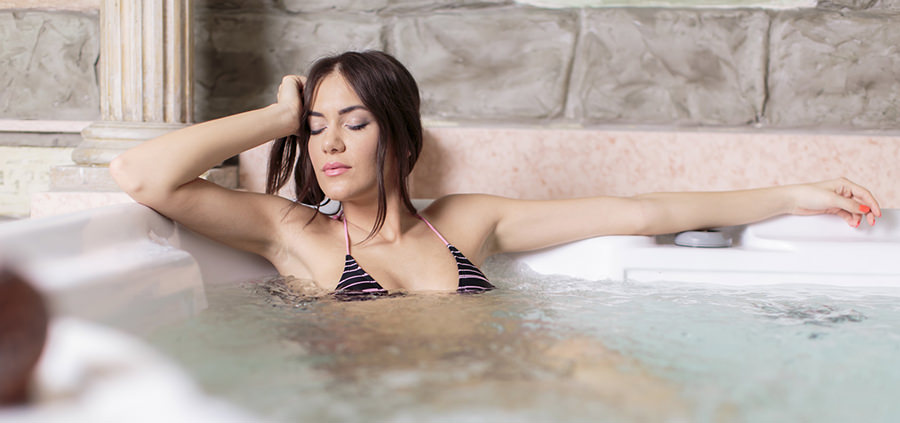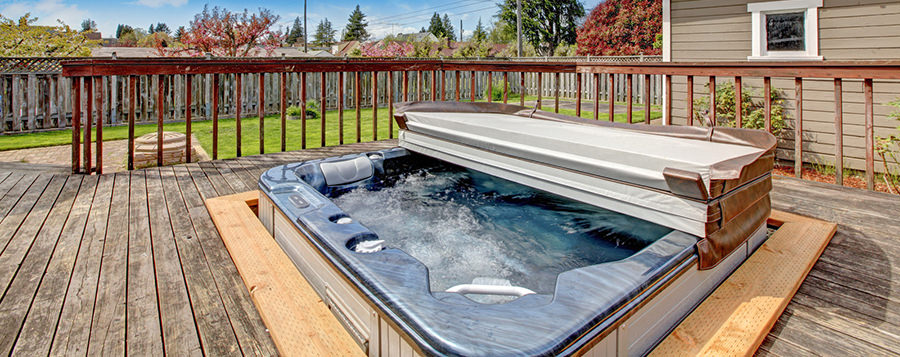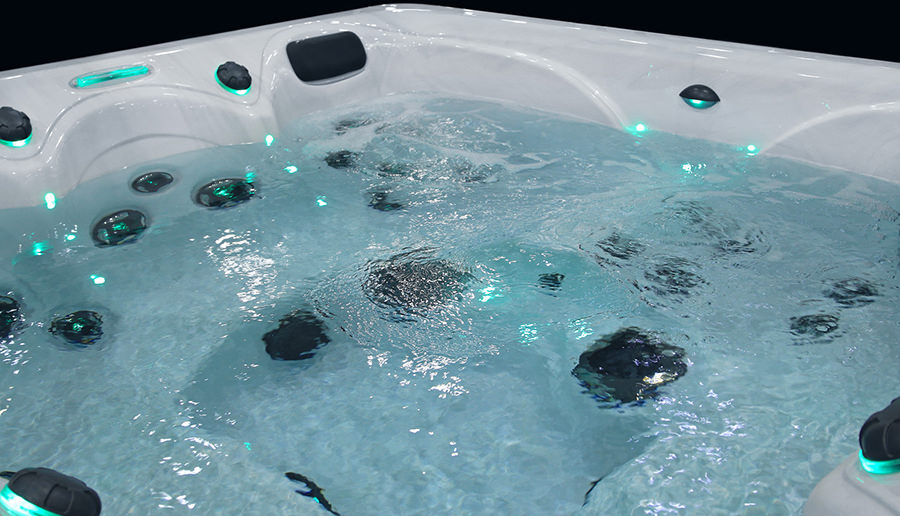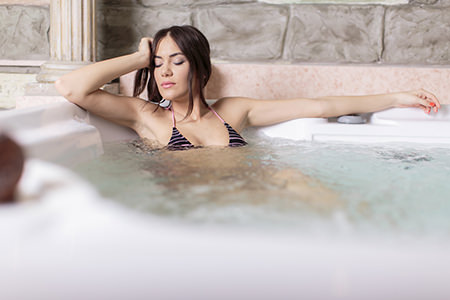
Knowing what chemicals you need for your hot tub is one of the most frequent causes of confusion for new hot tub owners. It’s not really surprising because, until you have got the hang of it, testing your water and adding chemicals does seem like a bit of a confusing and complicated process. However, with a bit of know-how, help and guidance, it really doesn’t need to be a worry and you will soon know exactly which chemicals you need to get for your hot tub, what they do, and when to use them.
I have always been a little bit disorganized with my hot tub chemicals and have just added whatever I thought was right without really understanding exactly what and why I was doing it. I decided to take the bull by the horns and find out exactly what I should and should not be adding to my hot tub. So, here is what I found out:
What hot tub chemicals do I need? Firstly you need PH testing strips and alkalinity balancers to ensure that the water PH is correct. A sanitizer to kill bacteria – most commonly chlorine or bromine. Shock (Oxidiser) – which is a weekly super sanitization, the type of shock you choose needs to match your chosen sanitizer. Calcium hardness increaser.
These are the basics and there are a number of other chemicals that it can be nice to have which can help to keep the water in good condition, solve particular water problems and also help with the general cleanliness of your hot tub. It’s also important that you understand when and why you need to use each of the chemicals to get the best results so let’s have a look at them in more detail.
Must have hot tub chemicals
PH testing strips and alkalinity balancers – before adding any chemicals to the water in your hot tub it’s really important that you test the total alkalinity level of the water and correct it if necessary. Once the alkalinity is correct you can go on to test the PH level. The PH level measures the acidity of the water. If the water is too acidic or alkaline it can cause skin problems and also corrosion problems within the hot tub itself. Also, if the PH level isn’t right then the sanitizer will be much less effective leading to the possibility that the bacteria in the hot tub will build up. You need a total alkalinity level of between 100 and 120 parts per million and a PH level between 7.4 and 7.6.
Testing these levels is really easy – all you do is buy a tub of test strips, remove a test strip (being careful not to let the sweat or oils from your hand contaminate it) dip the test strip in the water and then compare the color it changes to with the color chart on the side of the test strip tub. This will then tell you if you need to add any PH balancing chemicals to get the levels correct.
If you need to raise the alkalinity then use a hot tub alkalinity increaser.
If you need to lower the alkalinity then use a hot tub PH decreaser.
If you need to raise the PH then add a hot tub PH increaser.
If you need to lower the PH use a hot tub PH decreaser.
You will need to know how many gallons of water are in your hot tub so that you can check with the instructions on the balancing chemicals as to how much you need to add. Add the chemical by scattering over the surface of the water with the jets on so that the chemical gets distributed in the water thoroughly. Then, wait for 30 – 60 minutes, do another test and add balancing chemicals as needed. You might need to repeat this several times to get it right but it’s time well-spent because, if the PH levels aren’t right, it can lead to all sorts of problems later on.

Sanitizer – because hot tubs are essentially warm and wet they offer the ideal conditions for bacteria to thrive. To prevent this happening you need to add a sanitizer to the water to disinfect it, kill the bacteria and to keep it fresh and clean. The two most common sanitizers are chlorine and bromine. Chlorine is most frequently used, it’s less expensive than bromine and a bit easier to use in some ways. The main disadvantage to chlorine is that it can smell and some people can find it irritates their skin as well. It also needs the PH level of the water to be accurate to remain effective.
On the other hand, bromine doesn’t have a smell and can work effectively over a wider range of PH levels so, if you are really struggling to keep your PH under control then bromine might be the way to go. Often bromine tablets have to be put in a floating dispenser in the hot tub (which you might or might not find a problem) and you need to keep a careful eye on the levels as it builds up and doesn’t decay.
Assuming that you go for the most common chlorine option it’s a good idea to give fresh hot tub water a bit of a chlorine boost when you first add it to completely disinfect the water and kill any bacteria that might already be in there. Add chlorine until you reach a level of between 5 – 8 parts per million and then wait for around an hour before retesting. The chlorine level will gradually reduce – do not get into the hot tub until the chlorine level has dropped to a safe 2 – 4 parts per million which is the recommended level.
Shock (Oxidiser) – Shocking your hot tub sounds a bit weird! What could you possibly do in a hot tub to shock it?? Well, what it actually means is adding a shock dose of chemical after a period of time when the hot tub hasn’t been used, or after heavy use, or at the very least once a week. So, what does shocking your hot tub do? Firstly it zaps bacteria as well as removing bromamines and chloramines but most importantly it helps to clear organic matter from the water. Organic matter can soon add up if your hot tub is heavily used by several people and keeping it under control is essential to keeping the water fresh and clear. The shock chemical oxidizes the contaminants and releases them as a gas leaving the water clear.

It’s important that you use the right type of shock to match the sanitizer already in the water and also that you are careful to use the correct amount for your size of hot tub. It’s also a good idea to apply the shock treatment with the jets turned off and just the pump on. If the water in the hot tub is too swirly then the oxidization gas can be produced too quickly and it’s less effective. Also, make sure that the PH levels are correct before starting.
Once you have added the shock treatment leave the cover off the hot tub to allow the gas to escape. If you are using a chlorine shock treatment then you will need to wait for the chlorine levels to reduce down to a safe level before getting into the hot tub. The recommended levels are between 2-4 parts per million and it could take between 20 minutes and 24 hours to reduce down to this level after the shock treatment. If you are using a non-chlorine shock then you can generally enter the hot tub 20 minutes after the treatment. However, it’s important to read the directions on the shock treatment to be sure.
Calcium hardness – it’s important to measure the amount of calcium and magnesium in your hot tub’s water. All tap water contains both of these elements and, if the calcium level is too low it leads to erosion and damage to the working parts of your hot tub. You generally only need to check and adjust the calcium hardness of the water once each time the hot tub is refilled. The ideal level is between 175 – 250 parts per million.
This chemical is easily forgotten as it doesn’t directly impact the hot tub user in any way or give you any reminder that it’s not working via smelly or cloudy water for example. However, for you to get many years of reliable service out of your hot tub it’s important that you take the time to get this right.
Optional hot tub chemicals
Clarifiers – Clarifiers remove unwanted particles from the water and sort of “polish” the water to make it crystal clear. Essentially the chemical grabs the unwanted particles and clumps them together so that they can be removed by the hot tub’s filtration system. People tend to use clarifier when the water is cloudy or starts to smell.
However, to a certain extent clarifier is only a temporary solution that masks an underlying problem. This might be that the PH levels in the water are incorrect, the sanitizer levels are too low or that the hot tub water is due a change. Also, bear in mind that the filter may need cleaning and that adding clarifier can cause the filter to fill more quickly and the pump to work harder.
It’s always better all round to keep on top of your hot tub’s chemistry so that you don’t need to take evasive action if at all possible. To a certain extent clarifier is an emergency measure only.
Filter cleaning solution – it’s important to give the filter a good soak in filter cleaning solution to help get it really clean and to prolong it’s life. Regular filter cleaning and replacement is vital to keeping the water in good condition and also to prolong the life of your hot tub. A dirty filter takes it’s toll on the pump as it has to work harder and can also result in increased electricity charges as well so it’s important to maintain it regularly.
Mineral purifier – mineral purifier comes in stick form and goes in your hot tub’s filter area or skimmer basket. It cleans the water naturally by using a combination of copper, silver and zinc to remove bacteria. They are also coated with charcoal which also helps to remove impurities. Using a mineral purifier can greatly reduce the amount of sanitizer that you need and will mean that your water is being cleaned in a more natural, rather than a chemical way. This is great if you suffer from skin irritation due to sanitizer or just don’t like the idea of sitting in a pool of chemical!
The mineral sticks tend to last for about four months – just the perfect time to replace the stick when you change the water in your hot tub!
Hot tub cleaner – It can also be really helpful to have dedicated hot tub cleaner handy for cleaning the hot tub’s shell. Regular cleaning will ensure that mould and dirt doesn’t build up and it better than leaving the hot tub to get dirty and then doing just one big clean when you change the water. I did read recently that almost all household cleaners can be replaced with either bicarbonate or soda or white vinegar so they may do a good job as well but there is probably some peace of mind to be had from purchasing a good quality cleaning solution to protect an clean your hot tub investment as best you can.

“One off” hot tub chemicals
There are also a number of “one-off” chemicals that you might use infrequently to try to solve a particular problem. For example, it’s possible to buy defoamer to try to get rid of unsightly foam in your hot tub. Bear in mind though that, if your chemistry is correct and you are following a regular maintenance schedule you should have very few problems with your water. Often such “problem solving” chemicals are treating the symptom rather than the cause so beware.
Other helpful chemicals include biofilm cleaner to keep the jets and pumps clear of biofilm. This is an unpleasant algae that can grow and cause problems if you don’t look out for it. You can also get specific cleaners and treatments for your hot tub cover to keep it in tip-top condition and finally it can be useful to have some leak sealer handy just in case you do need to fix an unexpected leak!
So, hot tub chemicals aren’t really all that complicated after all! It seems that, as long as you have the basics and ensure that the alkalinity and PH are correct for a start, regularly check your sanitizer and shock regularly then your hot tub will remain pure and clear! Obviously, regular water changes and filter maintenance are vital as well. Often the problems people have seem to be from not keeping an eye on the chemistry and putting things right before they cause problems. It’s a great idea to get into a regular habit of checking your hot tub, it only takes a few moments each day and will pay dividends in the long term.
Related Questions
Is chlorine or bromine better for hot tubs? – Chlorine is the most popular as it is less expensive. Both are very good sanitizers but chlorine does have a particular smell and some people can find it irritates their skin. Bromine is odorless and will also work effectively over a wider range of PH than chlorine. However, it is more expensive and can be a bit more complicated to use.
What chemicals do I need for an inflatable hot tub? – You need to use the same chemicals for an inflatable hot tub as you need for a hard shell hot tub. So, you will need a sanitizer to kill the bacteria, PH balancers, shock to give the sanitizer a weekly boost and calcium hardness to protect the inner workings of the hot tub. You will also need a pot of test strips so that you can test the water and get the chemistry just right.
Can I use pool chemicals in my hot tub? – This isn’t a good idea. If fact using pool chemicals in a hot tub could potentially damage your hot tub and not be healthy for you either. The problem is that hot tubs operate at a much higher temperature than pools and so the chemicals need to be balanced appropriately. Your hot tub also has a much smaller concentration of water than a pool again making a completely different environment.
So, it always pays to buy the best quality hot tub specific chemicals to both look after your hot tub and you as well. Your hot tub is an expensive investment and chemicals, even high-quality ones, are relatively inexpensive. It simply doesn’t make any sense to risk your hot tub by using incorrect or poor quality chemicals.

